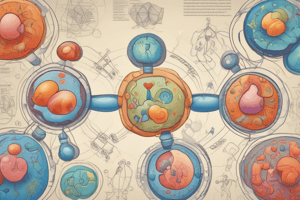Podcast
Questions and Answers
Which hormone inhibits lipolysis?
Which hormone inhibits lipolysis?
- Norepinephrine
- Epinephrine
- Glucagon
- Insulin (correct)
β-oxidation of fatty acids occurs in the cytoplasm.
β-oxidation of fatty acids occurs in the cytoplasm.
False (B)
What are the end products of lipolysis?
What are the end products of lipolysis?
glycerol and free fatty acids
The enzyme that converts DAG to MAG is called ______.
The enzyme that converts DAG to MAG is called ______.
Which molecule transports acyl-CoA into the mitochondria during fatty acid oxidation?
Which molecule transports acyl-CoA into the mitochondria during fatty acid oxidation?
Match the enzymes involved in lipolysis with their respective actions:
Match the enzymes involved in lipolysis with their respective actions:
How many ATP molecules are produced by one molecule of acetyl-CoA in the TCA cycle?
How many ATP molecules are produced by one molecule of acetyl-CoA in the TCA cycle?
The first step in β-oxidation is hydration.
The first step in β-oxidation is hydration.
During lipolysis, which enzyme converts triacylglycerol (TAG) to diacylglycerol (DAG)?
During lipolysis, which enzyme converts triacylglycerol (TAG) to diacylglycerol (DAG)?
The carnitine shuttle system is responsible for activating fatty acids in the cytoplasm prior to beta-oxidation.
The carnitine shuttle system is responsible for activating fatty acids in the cytoplasm prior to beta-oxidation.
What is the primary role of FADH₂ in β-oxidation?
What is the primary role of FADH₂ in β-oxidation?
The enzyme that catalyzes the rate-limiting step in the transport of fatty acyl-CoA into the mitochondria is ______.
The enzyme that catalyzes the rate-limiting step in the transport of fatty acyl-CoA into the mitochondria is ______.
Match the following enzymes or proteins with their primary function in fatty acid metabolism:
Match the following enzymes or proteins with their primary function in fatty acid metabolism:
Which of the following is NOT a product of β-oxidation?
Which of the following is NOT a product of β-oxidation?
Insulin stimulates lipolysis.
Insulin stimulates lipolysis.
What molecule serves as a carrier to transport fatty acids in the blood?
What molecule serves as a carrier to transport fatty acids in the blood?
Flashcards
What is Lipolysis?
What is Lipolysis?
The breakdown of triacylglycerols (TAGs) into glycerol and free fatty acids (FFAs).
What are the Stimulators of Lipolysis?
What are the Stimulators of Lipolysis?
Hormones that stimulate lipolysis, increasing the breakdown of TAGs.
Which Hormone Inhibits Lipolysis?
Which Hormone Inhibits Lipolysis?
A hormone that inhibits lipolysis, preserving TAGs during the fed state.
What is β-Oxidation?
What is β-Oxidation?
Signup and view all the flashcards
What enzyme activates fatty acids for β-oxidation?
What enzyme activates fatty acids for β-oxidation?
Signup and view all the flashcards
What is the Carnitine Shuttle System?
What is the Carnitine Shuttle System?
Signup and view all the flashcards
What is the 1st step of β-Oxidation?
What is the 1st step of β-Oxidation?
Signup and view all the flashcards
How many ATP molecules are produced from the complete oxidation of palmitic acid?
How many ATP molecules are produced from the complete oxidation of palmitic acid?
Signup and view all the flashcards
Where does lipolysis occur?
Where does lipolysis occur?
Signup and view all the flashcards
What stimulates lipolysis?
What stimulates lipolysis?
Signup and view all the flashcards
What inhibits lipolysis?
What inhibits lipolysis?
Signup and view all the flashcards
What is Acyl-CoA?
What is Acyl-CoA?
Signup and view all the flashcards
What does each β- oxidation cycle produce?
What does each β- oxidation cycle produce?
Signup and view all the flashcards
Study Notes
Triacylglycerol and Fatty Acid Catabolism
- Triacylglycerols (TAGs) and fatty acids (FAs) are broken down to provide energy during fasting or increased energy demand. This involves lipolysis and β-oxidation.
Lipolysis
- Definition: The breakdown of TAGs into glycerol and free fatty acids (FFAs).
- Location: Adipose tissue.
- Hormonal Regulation:
- Stimulators: Glucagon, epinephrine, norepinephrine.
- Inhibitor: Insulin (inhibits lipolysis during fed state).
- Hormones activate hormone-sensitive lipase (HSL) via cAMP-dependent protein kinase (PKA).
- Enzymatic Action:
- Adipose triglyceride lipase (ATGL): Converts TAG to diacylglycerol (DAG).
- Hormone-sensitive lipase (HSL): Converts DAG to monoacylglycerol (MAG).
- Monoacylglycerol lipase (MAGL): Converts MAG to glycerol and a free fatty acid (FFA).
- Products:
- Glycerol: Transported to the liver for gluconeogenesis or glycolysis.
- FFAs: Bind to albumin in the blood and are transported to energy-demanding tissues.
β-Oxidation of Fatty Acids
-
Definition: Stepwise removal of two-carbon units (as acetyl-CoA) from fatty acids for energy.
-
Location: Mitochondrial matrix. Long-chain fatty acids are first activated in the cytoplasm.
-
Activation:
- Fatty acid + CoA + ATP → Acyl-CoA + AMP + PPi.
- Enzyme: Acyl-CoA synthetase (thiokinase).
-
Transport into Mitochondria:
- Carnitine shuttle system moves acyl-CoA into the mitochondrial matrix.
- CPT I (carnitine palmitoyltransferase I): Converts acyl-CoA to acyl-carnitine (rate-limiting step).
- Acyl-carnitine transported into the matrix by a translocase.
- CPT II regenerates acyl-CoA in the matrix.
- Carnitine shuttle system moves acyl-CoA into the mitochondrial matrix.
-
β-Oxidation Proper (Spiral Pathway):
- 1st Step: Oxidation by acyl-CoA dehydrogenase → forms a double bond; FAD → FADH₂.
- 2nd Step: Hydration by enoyl-CoA hydratase → Adds water.
- 3rd Step: Oxidation by β-hydroxyacyl-CoA dehydrogenase → forms NADH.
- 4th Step: Cleavage by thiolase → produces acetyl-CoA and a shortened acyl-CoA.
-
Energy Yield (per cycle of β-oxidation):
- 1 FADH₂ → 1.5 ATP
- 1 NADH → 2.5 ATP
- Per Acetyl-CoA: Enters the TCA cycle for further ATP generation (1 Acetyl-CoA → 10 ATP).
-
Example (Palmitic Acid, C16):
- 7 cycles of β-oxidation → 7 FADH₂, 7 NADH, 8 acetyl-CoA.
- Total ATP: ~106 ATP (after accounting for activation energy).
Regulation
- Lipolysis:
- Stimulated by: Glucagon, epinephrine.
- Inhibited by: Insulin.
- β-Oxidation:
- Inhibited by: Malonyl-CoA (inhibits CPT I activity during FA synthesis).
- Stimulated by: High FA availability, fasting state.
Studying That Suits You
Use AI to generate personalized quizzes and flashcards to suit your learning preferences.




